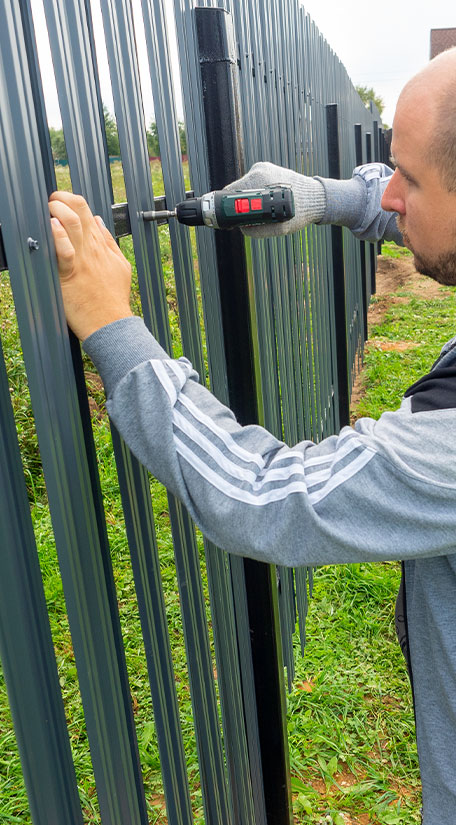South Carolina's Best Fence Company for Privacy, Protection, and Peace of Mind
Most homeowners agree that one of the best-looking, multi-purpose additions to a house is having a quality fence installed around the property. When it comes to aesthetics, affordability, and practicality, few upgrades are as popular as a new fence. They help safeguard your property when you're away, can keep your kids or pets safe and sound in your yard, and even prevent neighborly hazards from happening.
When built by professional fencing contractors in Daniel Island, SC residential fences can add curb appeal and resale value to your home, too. Whether you're looking to secure farm animals or want a little more privacy from your neighbors, installing a fence is a great, useful idea. When it comes to investing in your home, it's important you work with a trusted fencing company with years of experience. That's where Five Star Fencing comes in.
Our top-rated fencing company has built a reputation for building the most durable, attractive fences in metro Daniel Island, SC. Our model is simple: give our loyal customers the highest quality fence products at reasonable prices, installed by reliable fencing contractors in Daniel Island. Unlike some fence installation companies, we have built our reputation on hard work and true value. We strive to go the extra mile for our clients and do so with a friendly smile and helpful advice.
When you hire Five Star Fence Company for your fence installation project, know that you are working with the very best in the business. We take our work seriously because you trust us with the privacy, protection, and curb appeal of your home or business.
Fencing Contractors
- South Carolina's Best Fence Company for Privacy, Protection, and Peace of Mind
- The Premier Residential Fencing Company in Daniel Island, SC
- The Most Popular Residential Fence Designs in Daniel Island, SC
- Benefits of Fencing in Your Residential Property
- The Top Commercial Fence Contractor in Daniel Island, SC
- Quality Workmanship. Unmatched Fence Installation in Daniel Island, SC
When you work with Five Star Fence, you can always count on:
- The Finest Construction and Fence Installation in Daniel Island
- All Jobs Completed with Workers' Comp and General Liability Insurance
- Residential and Commercial Fencing Services
- Prompt, Reliable Installation
- Long-Term Fence Dependability
- Fencing Options Like Aluminum, Privacy, Picket, Chain Link, & More
- Free Quotes
- Friendly Service
We're proud to offer the same level of service for all our customers - whether they have a large commercial fencing project to
complete or a two-bedroom home that needs a privacy fence.
The Premier Residential Fencing Company in Daniel Island, SC
Whether you're looking to define property lines, enhance your home's security, boost curb appeal, or all three, having a fence built for your home is a great choice. Whether you choose a classic picket fence or a sturdy aluminum alternative, Carlina Fence Company has the tools, experience, and expert team to install a high-quality fence for your home.
If you know that you need a new fence but are unsure of where to start with the process, ask yourself these questions:
- Where will your fence be placed? Backyard? Front Yard? Both?
- What are concerns will a fence help alleviate? Privacy Security? Curb Appeal?
- Do you prefer certain fencing materials like metal or wood?
- Do you want a certain kind of fence like chain link or picket?
- What is your budget?
Once you can answer one or two of those questions, it's time to give Five Star Fence Company a call. Our knowledgeable, friendly team of fencing experts can help narrow down your affordable fencing choices. When you're ready, we'll take a trip to your home and provide a thorough, hassle-free quote for your consideration. Once we know the details and scope of your fence installation, we'll get to work building you a beautiful, sturdy fence that will last for years to come.
But with so many different fence styles available, it can be hard to choose which fence will be the perfect fit for your home. To help you select the right fence, consider these popular styles:

The Most Popular Residential Fence Designs in Daniel Island, SC
Usually, fences fall into three categories: decorative, functional, and privacy. Whether your plan is to use your fence for pet safety, family privacy, or property lines, Five Star Fence has plenty of options to choose from. With a myriad of materials like aluminum, wood, and vinyl, you're sure to find the perfect fence style for you and your family.

Privacy Fences: A great privacy fence not only protects your family from the prying eyes of strangers. It can be great for security, too. Available in a variety of materials like vinyl and wood, privacy fences transform spaces like backyards into secluded hideaways. Ask Five Star Fence about decorative options, too, like post caps, coordinating gates, and lattice panel tops.

Picket Fences: If you want to capture the essence of Americana, a picket fence might be your best choice. One of the most beloved styles of all time, many picket fences come with heavy-duty vinyl and feature extra-wide posts with slimmer top and bottom rails. You can also choose from several stylish wooden picket fences to enhance your home's appearance.

Chain Link Fences: Chain link fencing is one of the most common, cost-effective ways to keep your property safe. Available in galvanized and aluminized options, you can also select vinyl coated colors like black and green. For extra security, Five Star Fence Company can install barbed wire and even automatic gates if needed.

Aluminum Fences: Often considered the ultimate combo of beauty, durability, and strength, aluminum fencing enhances your home's curb appeal and protects too. Warranted by the manufacturer for life, aluminum fences at Five Star Fence Company come in many colors and styles. We even have a variety of heights to pick from as well, including special order aluminum fences.

Wooden Fences: From heavy-duty lattice fences made with pressure-washed pine to traditional estate-style split-rail fencing, wooden fences are affordable and effective. But wood fences do more than fill a need - they add value and style to your home. Fenced-in yards are a hot commodity in today's real estate market and can boost the value of your home if you're looking to sell. In terms of ROI, wood fencing is near the top of the list. At Five Star Fence Company, our design team will work closely with you to install the wooden fence of your dreams.
Benefits of Fencing in Your Residential Property
Whether you're looking to build a new fence out of necessity or as a beautiful addition to your home,
you may not be aware that there are many more benefits to installing a fence around your property.

Residential Fencing Protects Your Landscaping: Most South Carolina homeowners know that high winds and heavy rains are a common occurrence in our state. Those winds and rain can have a hugely negative effect on your home's landscaping, which you probably worked hard to perfect. Luckily, installing a fence can help prevent strong gusts of wind and help keep rain runoff from flooding your property. What's more, a wooden or aluminum fence from Five Star Fence Company will complement your landscaping style while protecting your shrubs and plants.

Residential Fencing Protects Kids & Pets: We have had the pleasure of working with many homeowners over the years. One of the most-cited reasons we hear for installing a residential fence is to protect kids and pets. If you're concerned about your tiniest family members wandering outside or into a neighbor's yard, installing a fence is a great preventative decision. Fencing in your front or backyard can also help keep out animal intruders, whether it's your neighbor's pets or a wilder animal.

Residential Fencing Minimizes Unsightly Views: Residential Fencing Minimizes Unsightly Views: If your neighbor's home is not exactly fit for a postcard, don't stress out. Our residential fencing company in Daniel Island, SC can install a great-looking fence to minimize views of unkempt or unattractive areas beyond your property line. Our vinyl and wood fencing options are very popular for this purpose, creating a beautiful enclosure for your family to enjoy.

Residential Fencing Creates a Sound Barrier: Believe it or not, many vinyl and wood privacy fences are used as sound barriers. Busy communities or neighborhoods close to major highways suffer from noise pollution. The same goes for homes located near train tracks. If you're sick and tired of hearing the highway every time you try to take a nap, our wooden privacy fences can minimize the sounds polluting your property.
The Top Commercial Fence Contractor
in Daniel Island, SC
As a licensed, insured company with decades of commercial fence installation experience, it's no wonder South Carolina's most respected commercial entities trust Five Star Fence with their commercial fencing projects. While residential fencing can be nuanced, commercial fencing is inherently complex, with a number of factors at play, like bids, deadlines, and employee downtime.
Unlike some commercial fencers in Daniel Island, our team is dedicated to quality, efficiency, and effectiveness. We know time is of the essence with your commercial project, which is why we work with your busy schedule to complete your project on time. Our goal is to go in and do our job professionally, accurately, and timely so your other subcontractors can begin their respective jobs.
Hiring a team of licensed, insured fencing contractors like you'll find at Five Star Fence ensures a proper return on your investment while protecting your property and employees.
If you're still on the "fence" about whether you should consider commercial fencing for your business or organization, contact our office today to learn more about the commercial installation side of our business. We'll take the time to explain our commercial installation process and help you choose the best fence for your business needs.

Frequently Asked Fencing Questions
At Five Star Fence, we do everything in our power to make your fence installation easy, streamlined, and effortless on your end. If you're considering a new fence installation, you probably have some questions about our process. To help address some of your concerns, here are answers to some of the most common questions that come across our desks.
Q. I need a fence installed for my home in Daniel Island. How long will it take?
A. A typical residential fence takes between two to four days to complete, depending on the size and build of your home. We will do our best to cater to your busy schedule and offer reliable fence installation services Monday-Friday. Should you have specific needs on the day of your fence installation, please let our staff know so that we can do our best to work with you.
Q. Another company told me that they don't use cement to secure posts in the ground. Is that true?
A. Absolutely not. Do not let anyone tell you that you do not need your posts cemented in the ground. At Five Star Fence, every post we plant is cemented into the ground, no questions asked. Depending on the type of fence that we're installing for you, your posts will be about 24-48 inches in the ground to ensure stability and durability.
Quality Workmanship. Unmatched Fence
Installation in Daniel Island, SC
Whether you need a new, beautiful wood fence to enhance curb appeal or an aluminum fence to help secure your residential property, Five Star Fence Company is here to help. After 28 years in the business, we have the knowledge and the experience to get the job done right. We pledge to provide you with honest work and the best fencing services in the Lowcountry. Contact our office today to get started on your free quote. Before you know it, your property will be a safer, more enjoyable place to spend time all year long.
 843-607-2855
843-607-2855
Get a Quote
Latest News in Daniel Island, SC
Luxury Daniel Island townhome development launches new phase
Jason Thomashttps://charlestonbusiness.com/luxury-daniel-island-townhome-development-launches-new-phase/
East West Partners, a luxury real estate developer, has launched sales for the initial offering in its third collection at the mixed-use community, The Waterfront Daniel Island, which features 11 townhomes.Located in the heart of the Waterfront, the 11 Sanderling townhomes offer approximately 2,900 to 3,500-square-feet of indoor living space, including an upstairs flex space perfect for a game room or den, in addition to a spacious, covered outdoor terrace and a...
East West Partners, a luxury real estate developer, has launched sales for the initial offering in its third collection at the mixed-use community, The Waterfront Daniel Island, which features 11 townhomes.
Located in the heart of the Waterfront, the 11 Sanderling townhomes offer approximately 2,900 to 3,500-square-feet of indoor living space, including an upstairs flex space perfect for a game room or den, in addition to a spacious, covered outdoor terrace and a two-car garage in each unit, according to an East West Partners news release.
Starting at $2 million, the development offers four floor plans.
“The Sanderling townhomes bring one of our most highly sought after residential product types back to the community and we couldn’t be more excited to share this latest collection,” said Harriette Calder, project manager for The Waterfront Daniel Island, in the release. “With sales launched in a phased approach, it allows us to listen to our buyers’ needs and adapt accordingly. This offering incorporates valuable feedback from our existing homeowners and emphasizes indoor/outdoor living to maintain coastal sensibilities.”
Related content: Construction begins on 278-unit community in Summerville
Related content: This CEO is the only South Carolina member of Forbes’ 400 Richest People in America list
The design vision for the third collection is led by Betsy Berry of B. Berry Interiors, the Charleston-based firm also behind the community’s second collection offering, the release stated. Berry creates a classic aesthetic throughout. Bluffton-based architecture firm Court Atkins Group is involved with the project.
Celebrating the best of waterfront living and the Lowcountry lifestyle, The Waterfront Daniel Island combines an elevated residential offering with premium community amenities, the release stated. Amenities include:
Other partners involved in the waterfront village include Hart Howerton, the master plan architect; Thomas & Hutton, the civil engineer and landscape architect; and Brockington and Associates, environmental consultants for the project. Phase II, which began construction in April 2022, is sold out and expected to deliver in early 2024. The master plan for the development of The Waterfront on Daniel Island includes a total of six phases.
Developers report sellout of The Waterfront Daniel Island Phase II
Charleston Businesshttps://charlestonbusiness.com/developers-report-sellout-of-the-waterfront-daniel-island-phase-ii/
All of the residences in Phase II at the mixed-use lifestyle community The Waterfront Daniel Island have been sold, a little more than a year after they were released, according to developers East West Partners.Phase II comprises 41 one-, two-, and three-bedroom condominium units across three new buildings, according to a news release from the development company.“We are thrilled to officially close out sales on this second residential phase at ,&rd...
All of the residences in Phase II at the mixed-use lifestyle community The Waterfront Daniel Island have been sold, a little more than a year after they were released, according to developers East West Partners.
Phase II comprises 41 one-, two-, and three-bedroom condominium units across three new buildings, according to a news release from the development company.
“We are thrilled to officially close out sales on this second residential phase at ,” Harriette Calder, project manager for The Waterfront Daniel Island, said in the release. “Demand for this community has remained strong ever since its inception, reflecting a continually growing interest in the elevated, yet relaxed coastal lifestyle and vibrant social environment we’ve been able to cultivate here. Our residents truly make this community a one-of-a-kind destination in the Lowcountry and we can’t wait to welcome our Phase II residents home to The Waterfront soon.”
Phase II, for which began construction in April 2022, will feature luxury condominium residences spread across the Sabal, Camellia and Magnolia buildings, most of which offer direct, unobstructed views of the Wando River. Ranging from approximately 1,220 to 3,400 square feet, floor plans in the second collection feature outdoor terraces, elevated finishes by interior designer Betsy Berry, and river views, with some penthouse units. In addition to the residences, this second collection also features exclusive new homeowner amenities, including a shared, elevated outdoor courtyard for residents of the Sabal and Magnolia buildings and an outdoor terrace and gathering space called The Perch for residents of the Camellia building. Construction is expected to be complete on units early in 2024, the release stated.
Later this fall, East West Partners expects to announce the release of sales for Phase III of the development, a new collection of 47 total residences including condominiums, townhomes and a handful of marsh cottages, representing a new product offering for the community. East West Partners will expand upon its collaboration with Berry for the interior design of Phase III products and will partner with two architectural firms, including MacMillan Pazdan Smith and Court Atkins, to bring the residences to life.
All homeowners who purchase at The Waterfront enjoy access to standout amenities, including:
Direct access to Daniel Island’s newly redesigned waterfront park, featuring two public docks with paddle launch and dog ramp, an interactive fountain, waterfront swings, and children’s play area.
Access to an array of natural and planned amenities, including 25+ miles of trails with views along the marsh and water; The Kingstide, Daniel Island’s only waterfront restaurant with rooftop bar; and The Daniel Island Market and Eatery (The Dime), a gourmet grab-and-go market.
Private amenities including a resort-style pool; pool pavilion with fire pit, fireplace, and grilling station; fitness center with state-of-the-art equipment; community outdoor gathering spaces; and post center with onsite property management.
The master plan for the development of The Waterfront on Daniel Island includes six phases.
s
Island resident organizes Spooky Tour
Emma Slavenhttp://thedanielislandnews.com/news/island-resident-organizes-spooky-tour
Provided by Elizabeth Roberts - Say hello to the 25-foot blow up Stay Puft Man at 182 Beresford Creek. Elizabeth Roberts and her kids love the giant light up display and her youngest thinks it is a snowman!You’re invited to enjoy a lineup of haunted housesGhosts, ghouls and goblins have found a home on Daniel Island, all thanks to the spirits of one islander family – Scott and Heather Engler.Some call this month October, others view it as Halloween time. Scott and his family only know it as spooky season, a t...
Provided by Elizabeth Roberts - Say hello to the 25-foot blow up Stay Puft Man at 182 Beresford Creek. Elizabeth Roberts and her kids love the giant light up display and her youngest thinks it is a snowman!
You’re invited to enjoy a lineup of haunted houses
Ghosts, ghouls and goblins have found a home on Daniel Island, all thanks to the spirits of one islander family – Scott and Heather Engler.
Some call this month October, others view it as Halloween time. Scott and his family only know it as spooky season, a time for haunted houses and eerie specters to roam the streets.
In 2021, he took it upon himself to transform the neighborhood into a thrilling maze of ghostly abodes, all for the pleasure of fellow neighbors and Halloween fanatics. The Daniel Island Spooky Tour was born out of a simple desire: to bring the spine-chilling joy of the spooky season closer to home.
Engler, the mind behind this frightful festivity, was inspired by the excitement his daughter Austen found in exploring haunted houses on James Island.
“When we first moved here in 2019, we saw the [James Island] houses and said, ‘Oh my gosh, this is better than Disney,’” Engler said.
Determined to create the same magic within Daniel Island (and tired of driving 30 minutes away), he organized a group of willing neighbors in transforming the island into a haunted wonderland, a place where families and friends can experience the thrill of the spooky season without venturing too far from home.
“At first it was just for friends, but then it blew up. Now I feel like I have an obligation.”
Now in its third year, the Daniel Island Spooky Tour invites all islanders and visitors to cruise around the neighborhoods and explore the front yards of 31 haunted houses – and counting.
In addition to the hair-raising tour, each haunted house is named in relation to their Halloween decorations. The creativity of the residents knows no bounds, as each house boasts its own unique theme. Residents can expect to see spine-tingling displays at houses such as “House of Skulls,” “Tarantula Lair,” “Web of Death” and more.
Lisa Strehmel, who has her “House of Dragons” on display, says she chose her theme based on her daughter’s love for dragons from a young age. “Our girls are out of high school now but we love continuing to decorate every year because the kids in the neighborhood love seeing the dragons so much!”
Fellow resident Joanna Loiselle has found the seasonal house transformation to be a family tradition. “We absolutely love Halloween on Daniel Island! The kids look forward to golf carting around to see the decorations each year. This is such a special community!”
Brace yourselves for a hauntingly delightful experience. This year, the Spooky Tour is taking it up a notch. Engler said since there will be so many people, it will have to be a “shotgun” or “choose your own adventure” kind of tour where everyone can start at different places and drive to see all 31 houses on their golf carts or cars.
This year’s tour will also include a contest of four categories, judging the houses on the spookiest house, most creative, most fun and overall best haunted house.
Residents and visitors are invited to decorate their golf carts and ride along the haunted houses on Sunday, Oct. 29, beginning at 6:30 p.m. and vote for their favorites. Post your photos and comments in the DI Spooky Tour 23 Facebook group.
For those who prefer to explore at their own pace, a handy map of the participating houses has been made available. Whether you travel by foot, golf cart, car or bike, Engler has created a self-guided tour of each participating house that has decked out on decorations. Each house can be found on the Maps app by visiting tinyurl.com/a336d5f3.
For fans of the island’s decorative tour, fear not. Engler is also the driving force behind the Cheer Tour, a festive neighborhood decoration tour featuring houses adorned with dazzling Christmas lights and ornaments.
Engler’s dedication to fostering a sense of community through these projects has evolved Daniel Island into an ever-vibrant hub of seasonal celebration.
“It gives you something to look forward to and feel like part of the community,” Engler said of his decoration tours. “It also gives people recognition of their homes. They put a lot of work into this.”
Engler and each Spooky Tour resident invite all islanders and visitors to stroll through the haunted streets of Daniel Island, a realm where the spooky and the spectacular collide. Happy hauntings, everyone!
The Spooky Tour houses are available to view from now until Halloween. Engler’s Christmas Cheer Tour will begin shortly after Thanksgiving.
Stay informed about Cainhoy and DI development projects
thedanielislandnews.comhttp://www.thedanielislandnews.com/news/stay-informed-about-cainhoy-and-di-development-projects
This week there are several developments coming before the various City of Charleston boards and committees. Below are those items as well as results, if any, from the prior week’s items specific to Daniel Island and the Cainhoy area. More detailed agendas and results can be found at charleston-sc.gov/agendacenter.UPCOMING: CITY OF CHARLESTON TECHNICAL REVIEW COMMITTEEOct. 26: Cainhoy Sports Park Amenity – Site plan for amenity, swimming pools, sports parks, parking lot, and stormwater pond on 23.5 acres at 3050 Riv...
This week there are several developments coming before the various City of Charleston boards and committees. Below are those items as well as results, if any, from the prior week’s items specific to Daniel Island and the Cainhoy area. More detailed agendas and results can be found at charleston-sc.gov/agendacenter.
UPCOMING: CITY OF CHARLESTON TECHNICAL REVIEW COMMITTEE
Oct. 26: Cainhoy Sports Park Amenity – Site plan for amenity, swimming pools, sports parks, parking lot, and stormwater pond on 23.5 acres at 3050 River Village Dr. TMS: B2620000008. Owner: Cainhoy Land & Timber, LLC. Contact: Steven Roach, roach.s@tandh.com.
Oct. 26: Towne at Cooper River Phase II - Road and infrastructure – Three separate items for road improvements to Enterprise Blvd, Beresford Run, and Clements Ferry Rd. and R/W extension, roadway construction, and master infrastructure to serve future development on 30.1 acres at 2620 Clements Ferry Rd. TMS: B2710001035. Applicant: Seamon, Whiteside & Associates, Inc. Contact: Spencer Plowden, splowden@seamonwhiteside.com.
Oct. 26: Woodfield Cooper River Farms – Site plan for 71 multifamily units on 2.7 acres at 700 Silo Acres Dr. TMS: B2710001035. Applicant: Seamon, Whiteside & Associates, Inc. Contact: Malcolm Glenn, mglenn@seamonwhiteside.com.
Oct. 26: Tuxbury Farm Tract - Concept plan for an 82-unit mixed-use development on15.1 acres at 2686 SC41. TMS: B2630004006.
Oct. 19: Woodfield Point Hope 3 Mixed – Site plan for multifamily and commercial mixed-use development for 348 units on 44.6 acres at 1260 Clements Ferry Road. TMS: B2620000028. Applicant: Seamon, Whiteside & Associates, Inc., Contact: Malcolm Glenn, mglenn@seamonwhiteside.com.
Oct. 19: Marshes at Daniel Island Phases 1A/1B – Review of revisions to approved road construction plans for a new residential subdivision consisting of 59 units on 16.78 acres at 146 Fairbanks Drive. TMS: B2710000010. Applicant: Seamon, Whiteside & Associates, Inc. Contact: Zachary Wortman, zwortman@seamonwhiteside.com.
Oct 19: Alliance Apartments Phase 1 – Site plan for multifamily development with supporting amenities and infrastructure at 1730 Clements Ferry Road, 336 units on 23.9 acres. Applicant: Seamon, Whiteside & Associates, Inc. Contact: Hannah Wilken, hwilken@seamonwhiteside.com.
Oct. 19: Cainhoy Del Webb Phase 2 – Preliminary plat and road construction plans for 233 lots of a new residential subdivision on Clements Ferry Rd. TMS: B2620000028. Applicant: Thomas & Hutton Engineering. Contact: Steven Roach, roach.s@tandh.com.
RESULTS: CITY OF CHARLESTON TECHNICAL REVIEW COMMITTEE
Oct. 12: Seven Farms at Pier View Pedestrian Improvements - Installation of curb extensions, Rectangular Rapid-Flashing Beacon (crossing signal), drainage, and roadway striping. Owner: City of Charleston Applicant: City of Charleston Contact: James Wallace, wallacej@charleston-sc.gov. Results: Revise and resubmit to TRC.
Oct. 12: Mikasa Apartments - Review of revisions to approved project, 336 units on 19.55 acres at 1980 Clements Ferry Rd. TMS: B2680000133. Applicant: Thomas & Hutton Engineering Contact: Corey Balenger, balenger.c@tandh.com. Results: Approval pending final documentation to Engineering and Planning.
Oct. 12: Parcel K Residential (Blaze Residential) - Site plan for 50 single-family attached townhomes and associated infrastructure on 5.58 acres at 716 Oyster Isle Dr. (Former Blackbaud and Charleston Battery site on Daniel Island Dr.) TMS: B2750000086. Applicant: Seamon, Whiteside & Associates. Contact: Abigail Richardson, arichardson@seamonwhiteside.com. Results: Open pending the delivery of comments from Stormwater Management.
Compiled by Suzanne Detar, sdetar@thedanielislandnews.com.
All meetings are open for public comment except the City of Charleston Technical Review Committee meetings.
Blue Raiders win Daniel Island Intercollegiate
Thomas Donleyhttps://goblueraiders.com/news/2023/10/31/mens-golf-blue-raiders-win-daniel-island-intercollegiate.aspx
Full Results Charleston, S.C. — Middle Tennessee men's golf used a hot start in Tuesday's third round to pick up a win at the Daniel Island Intercollegiate. Gavin Clements set a new personal best with a score of 67 (-5) in the third round, while ...
Full Results Charleston, S.C. — Middle Tennessee men's golf used a hot start in Tuesday's third round to pick up a win at the Daniel Island Intercollegiate. Gavin Clements set a new personal best with a score of 67 (-5) in the third round, while Kevin Jegers, Michael Barnard and Markus Varjun all finished within the top 15.
The Blue Raiders combined for eight birdies and an eagle on the front nine, compared to just four bogeys. Clements was responsible for the eagle and three of those birdies. He played even-par golf on the back nine for his second career-low round of the season.
The second half of the final round proved challenging for MTSU, as the Blue Raiders combined for 10 holes over par with just six birdies.
Jegers and Barnard finished the tournament in a tie for ninth at 213 (-3). Barnard was 2-under for the third round until a triple bogey on the 16th hole forced him to settle for a 73 (+1). Jegers carded a 76 (+4) in the third round.
Paired with his brother, Mattias, of VCU, Markus Varjun shot a 71 (-1) for the second straight round Tuesday. He tied for 15th individually at 216 (E).
Clements and Owen Stamper tied for 41st overall at 222 (+6).
By the Numbers 48 – The Blue Raiders' 48 birdies were the second-most in the tournament. 14 – Jegers tied for the most birdies in the tournament with 14. 30 – Varjun gained 30 spots on the individual leaderboard from the end of the first round to the end of the event.
Coach's Comments: Mark McEntire "What a great week! I am so proud of this team and glad we finished this one off! Round of the year from Gavin, and we needed it. Solid tournament by everyone and a great way to end the fall. Let's go!"
Tournament Notes
Follow the Blue Raiders
Follow Middle Tennessee Men's Golf on social media on Facebook /MTMGolf Twitter (@MT_MGolf) and Instagram (@mt_mgolf).
Disclaimer:

